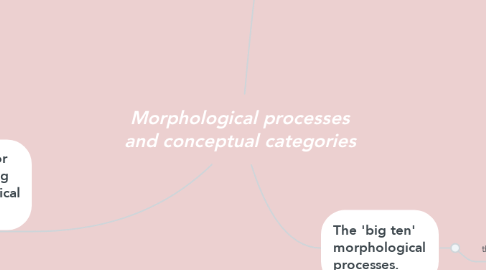
1. Methods for representing morphological processes
1.1. Prose
1.1.1. Where statements are the most communical way
1.1.1.1. of expressig facts
1.1.1.1.1. about grammatical structure
1.2. Position-class diagrams
1.2.1. Is very useful for describing languages
1.2.1.1. that tend to have lots of morphenes
1.2.1.1.1. per word
1.3. Process rules
1.3.1. Is a representation
1.3.1.1. that describes relationships
1.3.1.1.1. among the various shapes of words
2. Conceptual categories and the problem with labelling.
2.1. Must determine some pattern
2.1.1. or grammatical expression
2.1.1.1. for example
2.1.1.1.1. 'Past tense'
2.2. Reffers to
2.2.1. How categorization varies
2.2.1.1. from language to language
2.3. Is closely tied to
2.3.1. How to provide meaningful labels
2.3.1.1. of grammatical units
2.3.1.2. that are
2.3.1.2.1. Interpretations designed to help readers
3. The 'big ten' morphological processes.
3.1. that are
3.1.1. #1: Prefixation
3.1.1.1. The addition of a preffix
3.1.1.1.1. to the beggining of a root
3.1.2. #2: Suffixation
3.1.2.1. The addition of a suffix
3.1.2.1.1. to the end of a root
3.1.3. #3: Infixation
3.1.3.1. The addition of an infix
3.1.3.1.1. to the middle of a root
3.1.4. #4: Circumfixation
3.1.4.1. where one morphene has two parts
3.1.4.1.1. where
3.1.5. #5: Stem modification
3.1.5.1. Is a change in shape
3.1.5.1.1. where does not involve the addition
3.1.6. #6: Huto segmental variation
3.1.6.1. Is a change in shape
3.1.6.1.1. that does not involve consonants
3.1.7. #7: Reduplication
3.1.7.1. Involves the repetition of part or all
3.1.7.1.1. of a root
3.1.8. #8: Non-concatenative morphology
3.1.8.1. Is the superimposing a pattern of vowels
3.1.8.1.1. with a root with only consonants
3.1.9. #9: Subactive morphology
3.1.9.1. One or more segments are omitted
3.1.9.1.1. form a word
3.1.10. #10: Compounding
3.1.10.1. Involes combinning roots
3.1.10.1.1. to form new stems

